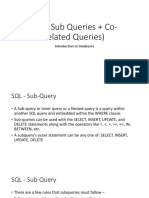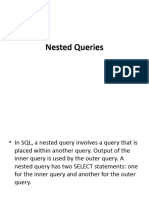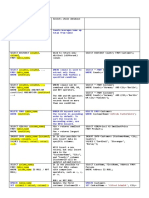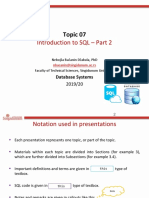Database Systems
Lab Manual 6
Learning Objectives
• Understanding of Subqueries in MySQL.
• Common Subquery Formats.
• Types of Subqueries.
LO1: Understanding of Subqueries in MySQL.
Subquery
A subquery in MySQL is a query nested inside another query. It can be
used with SELECT, INSERT, UPDATE, or DELETE statements.
Subqueries can appear in various clauses, such as WHERE, FROM, or
SELECT.
Subquery Rules in MySQL
• Subqueries must be enclosed in parentheses ().
• A subquery used with comparison operators must return a single
column.
• Subqueries in the SELECT clause must return a scalar value.
Example
Retrieve employees who have never handled an order.
Table: employees
EmployeeID FirstName LastName
1 Davolio Nancy
2 Fuller Andrew
3 Leverling Janet
4 Peacock Margret
5 Buchanan Steven
Database Systems-Manual 6 Page | 1
Table: orders
OrderID CustomerID EmployeeID
10248 90 5
10250 34 4
10251 84 3
10252 76 4
Requirements: Retrieve employees who have never handled an order
SELECT FirstName, LastName
FROM employees
WHERE EmployeeID NOT IN
(SELECT EmployeeID FROM orders);
Results:
FirstName LastName
Davolio Nancy
Fuller Andrew
Components of a Subquery
• SELECT Statement
• FROM Clause
• Optional WHERE, GROUP BY, HAVING Clauses
LO2: Common Subquery Formats
Understanding IN, ALL, ANY
The IN operator is used to check if a column’s value exists within a
specified list of values. It is a more concise way of writing multiple OR
conditions. For example, if we want to find all customers who belong
from Sweden or Canada, we can write:
Database Systems-Manual 6 Page | 2
select CustomerName
from customers
where Country IN ('Sweden', 'Canada');
This is equivalent to:
select CustomerName
from customers
where Country = 'Sweden' OR Country = 'Canada';
Using IN makes queries shorter and easier to read, especially when
working with long lists of values.
The ALL operator is used with comparison operators (>, <, >=, <=, !=)
to check if a value satisfies a condition against all values in a given set.
For example, if we want to find products that appear in all orders where
the quantity is exactly 10, we can use:
SELECT ProductName
FROM Products
WHERE ProductID = ALL
(SELECT ProductID
FROM OrderDetails
WHERE Quantity = 10);
This means that the product must be included in every single order
where the quantity is 10. If it appears in only some of them but not all,
it won’t be included in the result.
The ANY operator is similar to ALL, but instead of checking against all
values, it checks if the condition is true for at least one value in the
given set. For example, if we want to find products that appear in at
least one order where the quantity is exactly 10, we write:
SELECT ProductName
FROM Products
WHERE ProductID = ANY (SELECT ProductID
FROM OrderDetails
WHERE Quantity = 10);
Database Systems-Manual 6 Page | 3
This means a student will be included in the result if their marks are
greater than either 60, 70, or 80. Even if they don’t beat all three values,
if they beat at least one, they qualify.
WHERE expression [NOT] IN (subquery)
Example Get orders placed by customers that are not from
'Germany'
SELECT OrderID
FROM orders
WHERE CustomerID NOT IN (
SELECT CustomerID
FROM customers
Country = 'Germany'
);
WHERE expression comparison operator [ANY | ALL] (subquery)
Example: Returns products with a price higher than the most expensive
product in Category 2.
SELECT ProductName, Price
FROM products
WHERE Price > ALL (
SELECT Price
FROM products
WHERE categoryID=2);
WHERE IN (subquery)
Example: Get employees who have managed more than 10 orders
SELECT FirstName, LastName
FROM employees
WHERE EmployeeID IN (
Database Systems-Manual 6 Page | 4
SELECT EmployeeID
FROM orders
GROUP BY EmployeeID
HAVING COUNT(OrderID) > 10
);
LO3: Types of Subqueries.
Scalar Subquery
Subquery will return a single value (1 row, 1 column)
Example: Find products priced higher than average
SELECT ProductName
FROM products
WHERE Price > (
SELECT AVG(Price)
FROM products
);
Row Subquery
Subquery will return a single row (multiple columns)
Example: Find customer matching specific order details
SELECT CustomerName
FROM customers
WHERE (City, Country) = (
SELECT City, Country
FROM orders
JOIN customers USING(CustomerID)
WHERE OrderID = 10248
);
Database Systems-Manual 6 Page | 5
Column Subquery
Subquery will return a single column (multiple rows)
Example: Customers who placed orders
SELECT CustomerName
FROM customers
WHERE CustomerID IN (
SELECT DISTINCT CustomerID
FROM orders
);
Table Subquery
Subquery will return a full table (multiple rows/columns)
Example: Orders with total quantity > 100
SELECT *
FROM (
SELECT OrderID, SUM(Quantity) AS TotalQty
FROM orderdetails
GROUP BY OrderID
) AS OrderTotals
WHERE TotalQty > 100;
Correlated Subquery
References outer query values
Example: Employees who handled orders for each customer
SELECT CustomerName,
(SELECT CONCAT(FirstName, ' ', LastName)
FROM employees
WHERE employees.EmployeeID = orders.EmployeeID) AS Handler
FROM customers
Database Systems-Manual 6 Page | 6
JOIN orders USING(CustomerID);
Exists Subquery
Checks for existence of rows
Example: Suppliers with products in stock
SELECT SupplierName
FROM suppliers s
WHERE EXISTS (
SELECT 1
FROM products
WHERE SupplierID = s.SupplierID
);
Nested Subquery
Subquery within another subquery
Example: Find employees who handled orders containing the most
expensive product
SELECT FirstName, LastName
FROM employees
WHERE EmployeeID IN (
SELECT EmployeeID
FROM orders
WHERE OrderID IN (
SELECT OrderID
FROM orderdetails
WHERE ProductID = (
SELECT ProductID
FROM products
WHERE Price = (SELECT MAX(Price) FROM products)
)
)
);
Database Systems-Manual 6 Page | 7
Inline View (FROM Clause Subquery)
Subquery acting as temporary table
Example: Average order quantities
SELECT od.OrderID, od.Quantity
FROM orderdetails od
JOIN (
SELECT AVG(Quantity) AS AvgQty
FROM orderdetails
) AS avg_table
WHERE od.Quantity > avg_table.AvgQty;
Derived Table Subquery
Complex subquery in FROM clause
Example: Product list with category names
SELECT p.ProductName, c.CategoryName
FROM products p
JOIN (
SELECT CategoryID, CategoryName
FROM categories
) AS c ON p.CategoryID = c.CategoryID;
Quantified Comparison (ALL/ANY/SOME)
Example: Products more expensive than ALL Beverages
SELECT p.ProductName, c.CategoryName
FROM products p
JOIN (
SELECT CategoryID, CategoryName
FROM categories
) AS c ON p.CategoryID = c.CategoryID;SELECT ProductName
FROM products
WHERE Price > ALL (
SELECT Price
FROM products
Database Systems-Manual 6 Page | 8
WHERE CategoryID = (
SELECT CategoryID
FROM categories
WHERE CategoryName = 'Beverages'
)
);
Tasks:
1. Find products that have never been ordered. (ProductName)
2. List customers with no orders. (CustomerName)
3. Find suppliers providing 'Seafood' products. (SupplierName)
4. Find customers from same city as their suppliers.
(CustomerName)
5. Find most expensive product in each category. (ProductName,
CategoryID)
6. Find orders with total quantity > 100. (OrderID)
7. Find suppliers from same country as customers. (SupplierName)
8. Find employees handling >5 customers. (FirstName, LastName)
9. Find the most expensive product price. (ProductName, Price)
10. Find employees who have handled orders placed in 1997.
(FirstName, LastName)
11. Retrieve orders that contain products costing more than 50.
(OrderID)
12. Find suppliers who supply only one product. (SupplierName)
13. Get employees who handle orders containing 'Chai'. (FirstName,
LastName)
HackerRank Tasks
• The-Pads
• The-Company
• Weather-Observation-Station-18
• Weather-Observation-Station-19
Database Systems-Manual 6 Page | 9
• The-Report
• Full-Score
• Challenges
Submission on Eduko
Submit the following file in Zip on Eduko:
• 2024-CS-X.txt (Containing solution of all lab tasks)
• 2024-CS-X.docx (Execute all the example queries and add result
in tables in a word file as added in the first example – add max
10 records of each query if number of rows exceed 10).
Database Systems-Manual 6 Page | 10




























































































